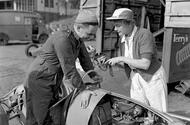Why Was Daphne Arnott’s Car Company So Remarkable?
When you think about the pioneers of the automotive world, the usual suspects are almost always men. But Daphne Arnott’s story breaks that mold in the most refreshing way. Her company, though it only lasted about a decade, stands out not just because she was a woman in a male-dominated field, but because she brought genuine innovation and grit to British motorsport.
So, what made Arnott’s company so special? For starters, it’s believed to be the only car manufacturer ever founded and run by a woman. That’s not just rare—it’s almost unheard of, even today. But beyond the headlines, Arnott’s approach to engineering, safety, and competition left a mark that’s still worth talking about.
How Did Daphne Arnott Get Into the Automotive World?
Daphne’s entry into the car business wasn’t exactly planned. Born in 1926, she grew up around engines—her father was a third-generation automotive engineer. She got her first taste of motorsport at Brooklands, watching a customer race with one of her father’s superchargers. But her own path took a few detours, including a stint in magazine publishing that didn’t pan out.
It was only after joining the family business in London that she really found her stride. There, she teamed up with George Thornton, a wartime aircraft engineer, and the two decided to build a car for the new Formula 3 category. This was post-war Britain, a time when resources were scarce and creativity was a must.
What Set Arnott’s Formula 3 Cars Apart From the Rest?
Arnott’s first Formula 3 car made its debut at Brands Hatch in 1951, and it was an instant attention-grabber. The car was quick—Autocar described it as “very fast”—but speed wasn’t its only claim to fame. Daphne was ahead of her time when it came to safety. Her F3 car was the first in its class to feature an integrated roll hoop and seatbelt. That might sound basic now, but back then, even Formula 1 drivers often raced without seatbelts.
Daphne insisted that every works driver use belts. The result? No fatalities in Arnott cars. There’s even a story about Dennis Taylor, a driver who rolled his Arnott at Brands Hatch. Thanks to the seatbelt, he stayed in the car as it landed on its wheels and kept racing. Had he been thrown out, the outcome could have been tragic.
Did Daphne Arnott Ever Race Herself?
You might wonder if Daphne ever took the wheel herself. She wanted to, but the era’s restrictions on women in motorsport were tough to overcome. She wasn’t interested in the so-called “ladies’ races,” which she dismissed as being more about socializing than serious competition. Daphne wanted to race on equal terms with the men, but the opportunities just weren’t there.
Still, she was no stranger to the pit lane. Contemporary press described her as a real mechanic, often seen with grease-stained hands, working alongside her team. When asked about her personal life, she famously quipped that her car was her boyfriend—it took up all her spare time.
How Did Arnott Push the Boundaries of Car Design?
Innovation was a constant theme for Arnott. In 1953, her team introduced a Formula 3 car with a fiberglass body—a first for the category. The new body was a third the weight of aluminum, and Daphne wasn’t shy about testing its toughness. She and her team kicked it around the garage and even jumped on it, just to prove it could take a beating.
But she didn’t stop there. As other teams set new speed records, Arnott’s crew built a streamlined body for their F3 car. Driver John Brise went on to break nine class records at Montlhéry, hitting speeds up to 122 mph. For a tiny 500cc car, that was nothing short of remarkable.
What Happened When Arnott Took on Le Mans?
By the mid-1950s, Daphne had her sights set on the world’s most famous endurance race: the 24 Hours of Le Mans. In 1955, her team entered a car painted in her favorite color—red, not the traditional British racing green. The only available driver was Peter Taylor, whose momentary distraction during practice led to a crash under the Dunlop Bridge. Thankfully, he walked away unscathed, but the incident was a major setback.
Undeterred, Arnott returned to Le Mans in 1957 with a new coupe featuring an innovative suspension system designed to increase grip at higher speeds. The car ran well until the fifth hour, when engine trouble forced it to retire. It was a tough break, but it showed just how far Daphne was willing to push the envelope.
What Became of Daphne Arnott and Her Legacy?
After her father’s death in 1961, Daphne took over the family business but soon decided to move on. She sold the company and relocated to Devon, where she ran a guest house with her husband. She brought the 1955 Le Mans car with her, and it’s since been lovingly restored.
Today, Daphne Arnott’s name might not be as widely recognized as some of her contemporaries, but her impact is undeniable. She proved that innovation and determination matter more than tradition or gender. Her focus on safety, her willingness to experiment with new materials, and her refusal to accept the status quo helped shape a small but significant chapter in motorsport history.
What Can We Learn From Daphne Arnott’s Story?
Daphne’s journey is a reminder that real progress often comes from those willing to break the rules—or at least question them. She didn’t set out to make history as a woman in motorsport; she just wanted to build better, safer, faster cars. In doing so, she opened doors for others and left a legacy that’s still inspiring today.
If there’s one takeaway, it’s this: sometimes, the most important innovations come from the least expected places. And sometimes, the best stories are the ones that don’t get told enough. Daphne Arnott’s is one of them.

